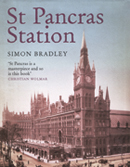St Pancras Station
Jeremy Musson enjoys an erudite and eloquently written history of a great London landmark from the age of steam


St Pancras Station - Simon Bradley (Profile Books, £14.99)
I have some sympathy with the hard-working architect George Gilbert Scott, who designed that great redbrick edifice, the Midland Grand Hotel at St Pancras. He was such a busy man that he was known to telegraph his assistants from provincial stations to ask: ?Why am I here??
The Midland Grand is perhaps his greatest legacy, certainly a great London landmark that has found its way (with its extremely fine adjoining train shed designed by W. H. Barlow) into an excellent series of small books on the Wonders of the World. It?s up there, in fact, with the Parthenon.
St Pancras Station is a beautifully written book of 180 pages, which explores the building, use and reputation of this remarkable complex. Simon Bradley?s erudition makes it not merely a pleasure to read, but also an excellent introduction to the 19th-century Gothic Revival (which so many moderns regard as backward looking, ignoring the sheer flexibility and ambition of the style) and the great age of railways. St Pancras is, after all, the one place where these two strands actually meet.
The author deals eloquently with many different subjects, not least the bitter campaign fought against the demolition of this marvellous complex, after the hotel closed as early as 1935 to become offices. (One chairman of the Gordon Hotel Company remarked in 1928 that hotels were like battleships, obsolete after 20 years.) All this has changed at St Pancras station, which is about to reopen this year.
I especially like Mr Bradley?s thoughts on the rather advanced sounding Ladies? Smoking Room of this great Victorian hotel, which, during the warmth of the summer, would have its doors thrown open towards the road: ?To imagine a fashionable lady of 1900 in the room, straining to decode the muffled chords of Wagner or Debussy above the roar of horseshoes and cartwheels, is to feel the poignancy of the gulf between the present and the not so distant past.?
Sign up for the Country Life Newsletter
Exquisite houses, the beauty of Nature, and how to get the most from your life, straight to your inbox.
Country Life is unlike any other magazine: the only glossy weekly on the newsstand and the only magazine that has been guest-edited by HRH The King not once, but twice. It is a celebration of modern rural life and all its diverse joys and pleasures — that was first published in Queen Victoria's Diamond Jubilee year. Our eclectic mixture of witty and informative content — from the most up-to-date property news and commentary and a coveted glimpse inside some of the UK's best houses and gardens, to gardening, the arts and interior design, written by experts in their field — still cannot be found in print or online, anywhere else.
-
 Vertigo at Victoria Falls, a sunset surrounded by lions and swimming in the Nile: A journey from Cape Town to Cairo
Vertigo at Victoria Falls, a sunset surrounded by lions and swimming in the Nile: A journey from Cape Town to CairoWhy do we travel and who inspires us to do so? Chris Wallace went in search of answers on his own epic journey the length of Africa.
By Christopher Wallace
-
 A gorgeous Scottish cottage with contemporary interiors on the bonny banks of the River Tay
A gorgeous Scottish cottage with contemporary interiors on the bonny banks of the River TayCarnliath on the edge of Strathtay is a delightful family home set in sensational scenery.
By James Fisher